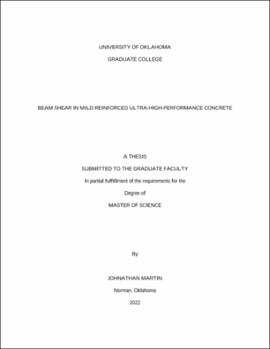| dc.description.abstract | Ultra-high-performance concrete (UHPC) is being utilized in bridge construction primarily for deck overlays and end-of-girder and beam repairs of deteriorated traditional concrete elements. UHPC has been used selectively in new construction to form full-sized structural members. Compared to conventional concrete, UHPC has the benefits of having higher compressive strength, being more ductile, and being self-consolidating. Because of these qualities, it can be used in very thin beams with shallower depths than a conventional concrete member could. Before it can be used on a larger scale more must be known about the failures that can occur. The current ACI Code (ACI 318-19 2019) places an upper limit on the compressive strength allowed in the shear capacity equation of 10,000 psi. UHPC can have strengths more than double this and may not behave as expected. The aim of this project was to quantify the shear capacity of UHPC beams. The testing regimen for this project included two conventional concrete beams and three UHPC beams. The mix for the conventional concrete was based on an Oklahoma Department of Transportation Class AA, having a compressive strength of approximately 9,000 psi. The UHPC followed the non-proprietary mix design develop at the University of Oklahoma, designated J3, which had a compressive strength of 17,000 psi.
The beam specimens tested were approximately a half-scale AASHTO Type B beam with some exaggerated proportions to better facilitate shear failure. All beams were of the same dimensions, having an overall depth of 16 in., an effective depth of 14.25 in., a web height of 8 in., and a web thickness of 2 in. A total beam length of 14 ft was chosen to allow for a 12-ft testing region under third-point loading. There were supports under the beam at 1 ft from each end and loading was applied 5 ft from each end, giving equivalent 4-ft uniform shearing
regions. All beams were fitted with a reinforcing cage having no shear reinforcement in the zones under shear. Longitudinal reinforcement included three #6 reinforcing bars. Each member was tested at 28 days to allow for full-strength development. The UHPC beams did not fail in shear. With approximately 4 in. of deflection, the beams exhibited significant flexural cracking and minor shear cracks. The maximum load for each UHPC specimen exceeded an equivalent shear capacity of over 9√𝑓′𝑐𝑏𝑤𝑑. From this research, it was concluded that the current ACI Code (2019) design guidance is insufficiently accurate and overly conservative for UHPC members, but more research is required. | en_US |
